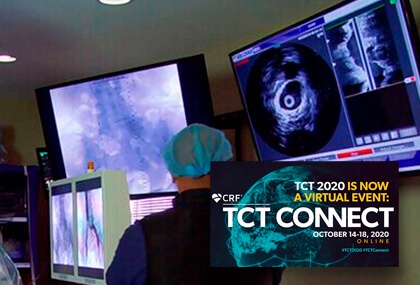The benefits of intravascular ultrasound (IVUS) guidance in all angioplasties with second-generation drug-eluting stents (DES) persist through 3 years of follow-up. These data derive from the extended follow-up of the ULTIMATE study, presented virtually at TCT 2020 and published simultaneously in JACC Intv.

At 3 years, target-vessel failure remained lower in patients whose angioplasty was guided by IVUS versus unguided angiography (6.6% vs. 10.7%; p = 0.01). This difference was mainly driven by a significant reduction in clinically-driven revascularization (4.5% vs. 6.9%; p = 0.05).
The advantage provided by IVUS guidance was even better when criteria for an optimal procedural result were met (plaque volume <50%, successful expansion, and lack of dissections).
Both the ULTIMATE and the IVUS-XPL (presented at TCT 2019 and also published in JACC Intv.) studies confirm the clinical benefits of IVUS-guided DES angioplasty.
Read also: TCT 2020 | TAVR Appears to Be the Solution for All Dysfunctional Biological Valves.
The ULTIMATE study, conducted at 8 Chinese sites, enrolled 1448 patients who had silent ischemia, stable or unstable angina, or acute infarction (the latter with over 24 hours between index chest pain and procedure). Of all patients, 78.5% presented acute coronary syndrome, 54.9% presented multivessel lesion, and 30.6% had diabetes. Patients in the IVUS arm received, on average, larger-diameter stents and much more frequently post-dilation with non-compliant balloons of larger diameter and at higher atmospheres.
Criteria for an optimal result were: minimum lumen area of the stent segment >5.0 mm2 or 90% of the minimum lumen area at the distal reference segments; plaque burden at 5 mm proximal or distal to stent edge <50%, and no edge dissection involving media with a length >3 mm.
The safety endpoint was definite or probable stent thrombosis, which was observed in 1 patient in the IVUS arm vs. 8 patients in the angiography arm (0.1% vs. 1.1%; p = 0.02).
Read also: TCT 2020 | Initial Studies Show Incredible Results with Lithotripsy in Calcified Lesions.
This research shows that IVUS guidance can improve angioplasty, reducing the need for repeat revascularization and stent thrombosis events.
Original title: Three-Year Outcomes of the ULTIMATE Trial Comparing Intravascular Ultrasound Versus Angiography-Guided Drug-Eluting Stent Implantation.
Reference: Xiao-Fei Gao et al. JACC: Cardiovascular Interventions, article in press. DOI: 10.1016/j.jcin.2020.10.001 y presentado simultáneamente en el congreso TCT 2020 virtual.
Subscribe to our weekly newsletter
Get the latest scientific articles on interventional cardiology





